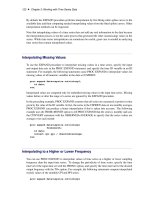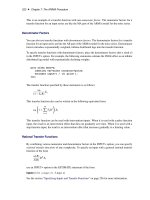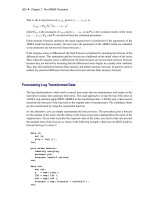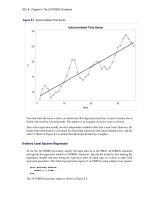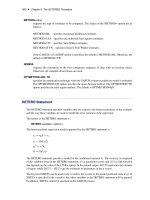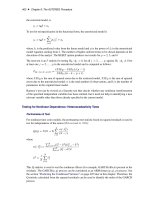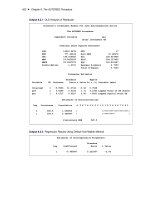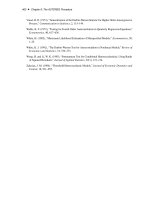SAS/ETS 9.22 User''''s Guide 17 pot
Bạn đang xem bản rút gọn của tài liệu. Xem và tải ngay bản đầy đủ của tài liệu tại đây (275.39 KB, 10 trang )
152 ✦ Chapter 4: Date Intervals, Formats, and Functions
TIME()
returns the current time of day.
TIMEPART( datetime )
returns the time part of a SAS datetime value.
TODAY()
returns the current date as a SAS date value. (TODAY is another name for the DATE function.)
WEEK( date < , ‘descriptor’ > )
returns the week of year from a SAS date value. The algorithm used to calculate the week
depends on the descriptor, which can take the value ‘U’, ‘V’, or ‘W’.
If the descriptor is ‘U,’ weeks start on Sunday and the range is
0
to
53
. If weeks
0
and
53
exist,
they are only partial weeks. Week 52 can be a partial week.
If the descriptor is ‘V’, the result is equivalent to the ISO 8601 week of year definition. The
range is
1
to
53
. Week
53
is a leap week. The first week of the year, Week
1
, and the last week
of the year, Week 52 or 53, can include days in another Gregorian calendar year.
If the descriptor is ‘W’, weeks start on Monday and the range is
0
to
53
. If weeks
0
and
53
exist, they are only partial weeks. Week 52 can be a partial week.
WEEKDAY( date )
returns the day of the week from a SAS date value. For example
WEEKDAY=WEEKDAY(’17OCT1991’D);
returns 5, the numerical value for Thursday.
YEAR( date )
returns the year from a SAS date value.
YYQ( year, quarter )
returns a SAS date value for year and quarter values.
References
National Retail Federation (2007), National Retail Federation 4-5-4 Calendar, Washington, DC:
NRF.
Technical Committee ISO/TC 154, D. E., Processes, Documents in Commerce, I., and Administra-
tion (2004), ISO 8601:2004 Data Elements and Interchange Formats–Information Interchange–
Representation of Dates and Times, 3rd Edition, Technical report, International Organization for
Standardization.
Chapter 5
SAS Macros and Functions
Contents
SAS Macros . . . . . . . . . . . . . . . . . . . . . . . . . . . . . . . . . . . . . . 153
BOXCOXAR Macro . . . . . . . . . . . . . . . . . . . . . . . . . . . . . . 154
DFPVALUE Macro . . . . . . . . . . . . . . . . . . . . . . . . . . . . . . . 157
DFTEST Macro . . . . . . . . . . . . . . . . . . . . . . . . . . . . . . . . 158
LOGTEST Macro . . . . . . . . . . . . . . . . . . . . . . . . . . . . . . . 160
Functions . . . . . . . . . . . . . . . . . . . . . . . . . . . . . . . . . . . . . . . 162
PROBDF Function for Dickey-Fuller Tests . . . . . . . . . . . . . . . . . . 162
References . . . . . . . . . . . . . . . . . . . . . . . . . . . . . . . . . . . . . . . 167
SAS Macros
This chapter describes several SAS macros and the SAS function PROBDF that are provided with
SAS/ETS software. A SAS macro is a program that generates SAS statements. Macros make it easy
to produce and execute complex SAS programs that would be time-consuming to write yourself.
SAS/ETS software includes the following macros:
%AR
generates statements to define autoregressive error models for the MODEL proce-
dure.
%BOXCOXAR
investigates Box-Cox transformations useful for modeling and forecasting a time
series.
%DFPVALUE computes probabilities for Dickey-Fuller test statistics.
%DFTEST performs Dickey-Fuller tests for unit roots in a time series process.
%LOGTEST
tests to see if a log transformation is appropriate for modeling and forecasting a
time series.
%MA
generates statements to define moving-average error models for the MODEL
procedure.
%PDL
generates statements to define polynomial-distributed lag models for the MODEL
procedure.
154 ✦ Chapter 5: SAS Macros and Functions
These macros are part of the SAS AUTOCALL facility and are automatically available for use in
your SAS program. See SAS Macro Language: Reference for information about the SAS macro
facility.
Since the %AR, %MA, and %PDL macros are used only with PROC MODEL, they are documented
with the MODEL procedure. See the sections on the %AR, %MA, and %PDL macros in Chap-
ter 18, “The MODEL Procedure,” for more information about these macros. The %BOXCOXAR,
%DFPVALUE, %DFTEST, and %LOGTEST macros are described in the following sections.
BOXCOXAR Macro
The %BOXCOXAR macro finds the optimal Box-Cox transformation for a time series.
Transformations of the dependent variable are a useful way of dealing with nonlinear relationships
or heteroscedasticity. For example, the logarithmic transformation is often used for modeling and
forecasting time series that show exponential growth or that show variability proportional to the level
of the series.
The Box-Cox transformation is a general class of power transformations that include the log transfor-
mation and no transformation as special cases. The Box-Cox transformation is
Y
t
D
(
.X
t
Cc/
1
for ¤ 0
ln.X
t
C c/ for D 0
The parameter
controls the shape of the transformation. For example,
=0 produces a log
transformation, while
=0.5 results in a square root transformation. When
=1, the transformed
series differs from the original series by c 1.
The constant c is optional. It can be used when some
X
t
values are negative or 0. You choose c so
that the series X
t
is always greater than c.
The %BOXCOXAR macro tries a range of
values and reports which of the values tried produces
the optimal Box-Cox transformation. To evaluate different
values, the %BOXCOXAR macro
transforms the series with each
value and fits an autoregressive model to the transformed series. It
is assumed that this autoregressive model is a reasonably good approximation to the true time series
model appropriate for the transformed series. The likelihood of the data under each autoregressive
model is computed, and the
value that produces the maximum likelihood over the values tried is
reported as the optimal Box-Cox transformation for the series.
The %BOXCOXAR macro prints and optionally writes to a SAS data set all of the
values tried, the
corresponding log-likelihood value, and related statistics for the autoregressive model.
You can control the range and number of
values tried. You can also control the order of the
autoregressive models fit to the transformed series. You can difference the transformed series before
the autoregressive model is fit.
BOXCOXAR Macro ✦ 155
Note that the Box-Cox transformation might be appropriate when the data have a common distribution
(apart from heteroscedasticity) but not when groups of observations for the variable are quite different.
Thus the %BOXCOXAR macro is more often appropriate for time series data than for cross-sectional
data.
Syntax
The form of the %BOXCOXAR macro is
%BOXCOXAR ( SAS-data-set, variable < , options > ) ;
The first argument, SAS-data-set, specifies the name of the SAS data set that contains the time series
to be analyzed. The second argument, variable, specifies the time series variable name to be analyzed.
The first two arguments are required.
The following options can be used with the %BOXCOXAR macro. Options must follow the required
arguments and are separated by commas.
AR=n
specifies the order of the autoregressive model fit to the transformed series. The default is
AR=5.
CONST=value
specifies a constant c to be added to the series before transformation. Use the CONST= option
when some values of the series are 0 or negative. The default is CONST=0.
DIF=( differencing-list )
specifies the degrees of differencing to apply to the transformed series before the autoregressive
model is fit. The differencing-list is a list of positive integers separated by commas and enclosed
in parentheses. For example, DIF=(1,12) specifies that the transformed series be differenced
once at lag 1 and once at lag 12. For more details, see the section “IDENTIFY Statement” on
page 231 in Chapter 7, “The ARIMA Procedure.”
LAMBDAHI=value
specifies the maximum value of lambda for the grid search. The default is LAMBDAHI=1. A
large (in magnitude) LAMBDAHI= value can result in problems with floating point arithmetic.
LAMBDALO=value
specifies the minimum value of lambda for the grid search. The default is LAMBDALO=0. A
large (in magnitude) LAMBDALO= value can result in problems with floating point arithmetic.
NLAMBDA=value
specifies the number of lambda values considered, including the LAMBDALO= and LAMB-
DAHI= option values. The default is NLAMBDA=2.
OUT=SAS-data-set
writes the results to an output data set. The output data set includes the lambda values tried
(LAMBDA), and for each lambda value, the log likelihood (LOGLIK), residual mean squared
error (RMSE), Akaike Information Criterion (AIC), and Schwarz’s Bayesian Criterion (SBC).
156 ✦ Chapter 5: SAS Macros and Functions
PRINT=YES | NO
specifies whether results are printed. The default is PRINT=YES. The printed output contains
the lambda values, log likelihoods, residual mean square errors, Akaike Information Criterion
(AIC), and Schwarz’s Bayesian Criterion (SBC).
Results
The value of
that produces the maximum log likelihood is returned in the macro variable
&BOXCOXAR
. The value of the variable &BOXCOXAR is “ERROR” if the %BOXCOXAR macro is
unable to compute the best transformation due to errors. This might be the result of large lambda
values. The Box-Cox transformation parameter involves exponentiation of the data, so that large
lambda values can cause floating-point overflow.
Results are printed unless the PRINT=NO option is specified. Results are also stored in SAS data
sets when the OUT= option is specified.
Details
Assume that the transformed series
Y
t
is a stationary pth order autoregressive process generated by
independent normally distributed innovations.
.1 ‚.B//.Y
t
/ D
t
t
iid N.0;
2
/
Given these assumptions, the log-likelihood function of the transformed data Y
t
is
l
Y
./ D
n
2
ln.2/
1
2
ln.j†j/
n
2
ln.
2
/
1
2
2
.Y 1/
0
†
1
.Y 1/
In this equation, n is the number of observations,
is the mean of
Y
t
,
1
is the n-dimensional column
vector of 1s,
2
is the innovation variance, Y D .Y
1
; ; Y
n
/
0
, and † is the covariance matrix of Y.
The log-likelihood function of the original data X
1
; ; X
n
is
l
X
./ D l
Y
./ C . 1/
n
X
tD1
ln.X
t
C c/
where c is the value of the CONST= option.
For each value of
, the maximum log-likelihood of the original data is obtained from the maximum
log-likelihood of the transformed data given the maximum likelihood estimate of the autoregressive
model.
The maximum log-likelihood values are used to compute the Akaike Information Criterion (AIC) and
Schwarz’s Bayesian Criterion (SBC) for each
value. The residual mean squared error based on the
DFPVALUE Macro ✦ 157
maximum likelihood estimator is also produced. To compute the mean squared error, the predicted
values from the model are transformed again to the original scale (Pankratz 1983, pp. 256–258, and
Taylor 1986).
After differencing as specified by the DIF= option, the process is assumed to be a stationary
autoregressive process. You can check for stationarity of the series with the %DFTEST macro. If
the process is not stationary, differencing with the DIF= option is recommended. For a process with
moving-average terms, a large value for the AR= option might be appropriate.
DFPVALUE Macro
The %DFPVALUE macro computes the significance of the Dickey-Fuller test. The %DFPVALUE
macro evaluates the
p
-value for the Dickey-Fuller test statistic
for the test of H
0
: “The time series
has a unit root” versus H
a
: “The time series is stationary” using tables published by Dickey (1976)
and Dickey, Hasza, and Fuller (1984).
The %DFPVALUE macro can compute
p
-values for tests of a simple unit root with lag 1 or for
seasonal unit roots at lags 2, 4, or 12. The %DFPVALUE macro takes into account whether an
intercept or deterministic time trend is assumed for the series.
The %DFPVALUE macro is used by the %DFTEST macro described later in this chapter.
Note that the %DFPVALUE macro has been superseded by the PROBDF function described later in
this chapter. It remains for compatibility with past releases of SAS/ETS.
Syntax
The %DFPVALUE macro has the following form:
%DFPVALUE ( tau, nobs < , options > ) ;
The first argument, tau, specifies the value of the Dickey-Fuller test statistic.
The second argument, nobs, specifies the number of observations on which the test statistic is based.
The first two arguments are required. The following options can be used with the %DFPVALUE
macro. Options must follow the required arguments and are separated by commas.
DLAG=1 | 2 | 4 | 12
specifies the lag period of the unit root to be tested. DLAG=1 specifies a one-period unit root
test. DLAG=2 specifies a test for a seasonal unit root with lag 2. DLAG=4 specifies a test for
a seasonal unit root with lag 4. DLAG=12 specifies a test for a seasonal unit root with lag 12.
The default is DLAG=1.
TREND=0 | 1 | 2
specifies the degree of deterministic time trend included in the model. TREND=0 specifies
no trend and assumes the series has a zero mean. TREND=1 includes an intercept term.
158 ✦ Chapter 5: SAS Macros and Functions
TREND=2 specifies both an intercept and a deterministic linear time trend term. The default is
TREND=1. TREND=2 is not allowed with DLAG=2, 4, or 12.
Results
The computed p-value is returned in the macro variable &DFPVALUE. If the p-value is less than 0.01
or larger than 0.99, the macro variable &DFPVALUE is set to 0.01 or 0.99, respectively.
Minimum Observations
The minimum number of observations required by the %DFPVALUE macro depends on the value of
the DLAG= option. The minimum observations are as follows:
DLAG= Minimum Observations
1 9
2 6
4 4
12 12
DFTEST Macro
The %DFTEST macro performs the Dickey-Fuller unit root test. You can use the %DFTEST macro
to decide whether a time series is stationary and to determine the order of differencing required for
the time series analysis of a nonstationary series.
Most time series analysis methods require that the series to be analyzed is stationary. However,
many economic time series are nonstationary processes. The usual approach to this problem is to
difference the series. A time series that can be made stationary by differencing is said to have a unit
root. For more information, see the discussion of this issue in the section “Getting Started: ARIMA
Procedure” on page 195 of Chapter 7, “The ARIMA Procedure.”
The Dickey-Fuller test is a method for testing whether a time series has a unit root. The %DFTEST
macro tests the hypothesis H
0
: “The time series has a unit root” versus H
a
: “The time series is
stationary” based on tables provided in Dickey (1976) and Dickey, Hasza, and Fuller (1984). The
test can be applied for a simple unit root with lag 1, or for seasonal unit roots at lag 2, 4, or 12.
Note that the %DFTEST macro has been superseded by the PROC ARIMA stationarity tests. See
Chapter 7, “The ARIMA Procedure,” for details.
Syntax
The %DFTEST macro has the following form:
%DFTEST ( SAS-data-set, variable < , options > ) ;
DFTEST Macro ✦ 159
The first argument, SAS-data-set, specifies the name of the SAS data set that contains the time series
variable to be analyzed.
The second argument, variable, specifies the time series variable name to be analyzed.
The first two arguments are required. The following options can be used with the %DFTEST macro.
Options must follow the required arguments and are separated by commas.
AR=n
specifies the order of autoregressive model fit after any differencing specified by the DIF= and
DLAG= options. The default is AR=3.
DIF=( differencing-list )
specifies the degrees of differencing to be applied to the series. The differencing list is a list of
positive integers separated by commas and enclosed in parentheses. For example, DIF=(1,12)
specifies that the series be differenced once at lag 1 and once at lag 12. For more details, see
the section “IDENTIFY Statement” on page 231 in Chapter 7, “The ARIMA Procedure.”
If the option DIF=( d
1
,
, d
k
) is specified, the series analyzed is
.1 B
d
1
/.1 B
d
k
/Y
t
,
where Y
t
is the variable specified, and B is the backshift operator defined by BY
t
D Y
t1
.
DLAG=1 | 2 | 4 | 12
specifies the lag to be tested for a unit root. The default is DLAG=1.
OUT=SAS-data-set
writes residuals to an output data set.
OUTSTAT=SAS-data-set
writes the test statistic, parameter estimates, and other statistics to an output data set.
TREND=0 | 1 | 2
specifies the degree of deterministic time trend included in the model. TREND=0 includes no
deterministic term and assumes the series has a zero mean. TREND=1 includes an intercept
term. TREND=2 specifies an intercept and a linear time trend term. The default is TREND=1.
TREND=2 is not allowed with DLAG=2, 4, or 12.
Results
The computed p-value is returned in the macro variable &DFTEST. If the p-value is less than 0.01 or
larger than 0.99, the macro variable &DFTEST is set to 0.01 or 0.99, respectively. (The same value is
given in the macro variable &DFPVALUE returned by the %DFPVALUE macro, which is used by the
%DFTEST macro to compute the p-value.)
Results can be stored in SAS data sets with the OUT= and OUTSTAT= options.
Minimum Observations
The minimum number of observations required by the %DFTEST macro depends on the value of the
DLAG= option. Let s be the sum of the differencing orders specified by the DIF= option, let t be the
160 ✦ Chapter 5: SAS Macros and Functions
value of the TREND= option, and let p be the value of the AR= option. The minimum number of
observations required is as follows:
DLAG= Minimum Observations
1 1 C p C s Cmax.9; p Ct C 2/
2 2 C p C s Cmax.6; p Ct C 2/
4 4 C p Cs Cmax.4; p Ct C2/
12 12 C p Cs Cmax.12; p Ct C 2/
Observations are not used if they have missing values for the series or for any lag or difference used
in the autoregressive model.
LOGTEST Macro
The %LOGTEST macro tests whether a logarithmic transformation is appropriate for modeling and
forecasting a time series. The logarithmic transformation is often used for time series that show
exponential growth or variability proportional to the level of the series.
The %LOGTEST macro fits an autoregressive model to a series and fits the same model to the log
of the series. Both models are estimated by the maximum-likelihood method, and the maximum
log-likelihood values for both autoregressive models are computed. These log-likelihood values are
then expressed in terms of the original data and compared.
You can control the order of the autoregressive models. You can also difference the series and the
log-transformed series before the autoregressive model is fit.
You can print the log-likelihood values and related statistics (AIC, SBC, and MSE) for the autore-
gressive models for the series and the log-transformed series. You can also output these statistics to a
SAS data set.
Syntax
The %LOGTEST macro has the following form:
%LOGTEST ( SAS-data-set, variable, < options > ) ;
The first argument, SAS-data-set, specifies the name of the SAS data set that contains the time series
variable to be analyzed. The second argument, variable, specifies the time series variable name to be
analyzed.
The first two arguments are required. The following options can be used with the %LOGTEST
macro. Options must follow the required arguments and are separated by commas.
AR=n
specifies the order of the autoregressive model fit to the series and the log-transformed series.
The default is AR=5.
LOGTEST Macro ✦ 161
CONST=value
specifies a constant to be added to the series before transformation. Use the CONST= option
when some values of the series are 0 or negative. The series analyzed must be greater than the
negative of the CONST= value. The default is CONST=0.
DIF=( differencing-list )
specifies the degrees of differencing applied to the original and log-transformed series before
fitting the autoregressive model. The differencing-list is a list of positive integers separated by
commas and enclosed in parentheses. For example, DIF=(1,12) specifies that the transformed
series be differenced once at lag 1 and once at lag 12. For more details, see the section
“IDENTIFY Statement” on page 231 in Chapter 7, “The ARIMA Procedure.”
OUT=SAS-data-set
writes the results to an output data set. The output data set includes a variable TRANS that
identifies the transformation (LOG or NONE), the log-likelihood value (LOGLIK), residual
mean squared error (RMSE), Akaike Information Criterion (AIC), and Schwarz’s Bayesian
Criterion (SBC) for the log-transformed and untransformed cases.
PRINT=YES | NO
specifies whether the results are printed. The default is PRINT=NO. The printed output shows
the log-likelihood value, residual mean squared error, Akaike Information Criterion (AIC),
and Schwarz’s Bayesian Criterion (SBC) for the log-transformed and untransformed cases.
Results
The result of the test is returned in the macro variable &LOGTEST. The value of the &LOGTEST
variable is ‘LOG’ if the model fit to the log-transformed data has a larger log likelihood than the
model fit to the untransformed series. The value of the &LOGTEST variable is ‘NONE’ if the model
fit to the untransformed data has a larger log likelihood. The variable &LOGTEST is set to ‘ERROR’
if the %LOGTEST macro is unable to compute the test due to errors.
Results are printed when the PRINT=YES option is specified. Results are stored in SAS data sets
when the OUT= option is specified.
Details
Assume that a time series
X
t
is a stationary pth order autoregressive process with normally distributed
white noise innovations. That is,
.1 ‚.B//.X
t
x
/ D
t
where
x
is the mean of X
t
.
The log likelihood function of X
t
is
l
1
./ D
n
2
ln.2/
1
2
ln.j†
xx
j/
n
2
ln.
2
e
/
1
2
2
e
.X 1
x
/
0
†
1
xx
.X 1
x
/

